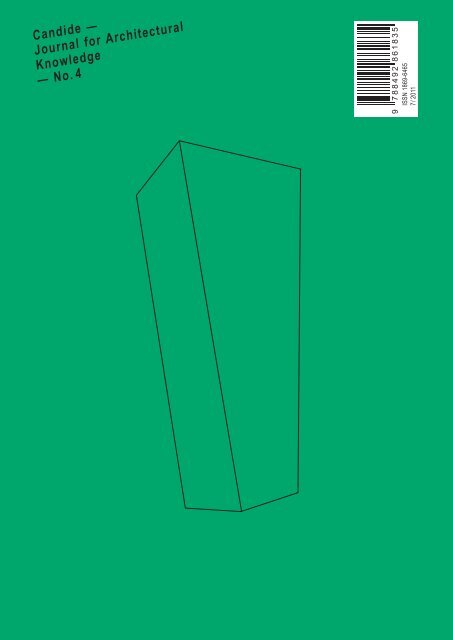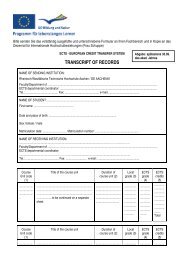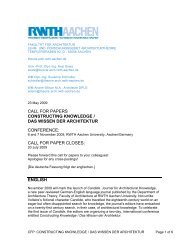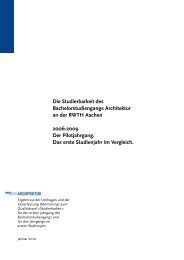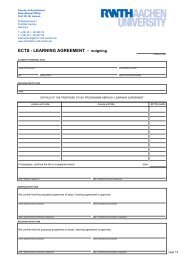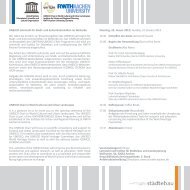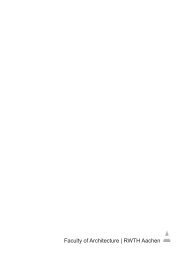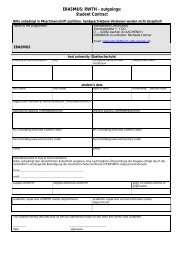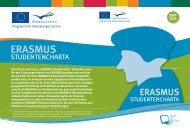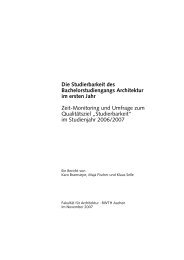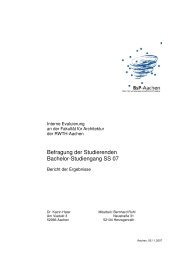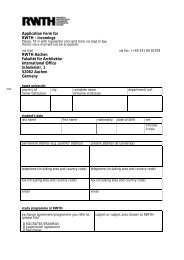Candide No.4 - RWTH Aachen - RWTH Aachen University
Candide No.4 - RWTH Aachen - RWTH Aachen University
Candide No.4 - RWTH Aachen - RWTH Aachen University
Sie wollen auch ein ePaper? Erhöhen Sie die Reichweite Ihrer Titel.
YUMPU macht aus Druck-PDFs automatisch weboptimierte ePaper, die Google liebt.
9 7 8 8 4 9 2 8 6 1 8 3 5<br />
ISSN 1869-6465<br />
7 / 2011<br />
C4_Heft1.indd 1 01.08.11 12:34
<strong>Candide</strong> —<br />
Journal for Architectural Knowledge<br />
is a scholarly journal published<br />
twice a year at the Department<br />
for Theory of Architecture, Faculty<br />
of Architecture, <strong>RWTH</strong> <strong>Aachen</strong><br />
<strong>University</strong>.<br />
<strong>Candide</strong> —<br />
Journal for Architectural Knowledge<br />
ist eine wissenschaftliche Zeitschrift,<br />
die zweimal jährlich am<br />
Lehr- und Forschungsgebiet<br />
Architekturtheorie, Fakultät für<br />
Architektur, <strong>RWTH</strong> <strong>Aachen</strong><br />
herausgegeben wird.<br />
<strong>Candide</strong> is funded in part by the<br />
German Research Foundation’s<br />
program “Scientific Journals.”<br />
<strong>Candide</strong> wird im Rahmen des<br />
Programms „Wissenschaftliche<br />
Zeitschriften“ der Deutschen<br />
Forschungsgemeinschaft<br />
gefördert.<br />
Media partner<br />
C4_Heft1.indd 2 01.08.11 12:34
4<br />
9<br />
37<br />
69<br />
89<br />
121<br />
Analysis<br />
Encounters<br />
Essay<br />
Project<br />
Fiction<br />
Contents<br />
Letter from the Editors<br />
Submissions<br />
Colophon<br />
Michael Guggenheim<br />
Formless Discourse:<br />
The Impossible Knowledge<br />
of Change of Use<br />
Urs Füssler and Jörg Leeser<br />
The Flower Shop in Oberbarmen:<br />
The Wuppertal<br />
Studio and Seminar<br />
Irénée Scalbert<br />
The Architect as<br />
Bricoleur<br />
Liam Ross<br />
Compliant Architecture:<br />
Regulatory Limits and the<br />
Materiality of Risk<br />
Joachim Geil and<br />
Reinhard Doubrawa<br />
Out-of-doors:<br />
The Architect and the<br />
Emperor of Assyria<br />
Inhalt<br />
Editorial<br />
Hinweise für Einreichungen<br />
Impressum<br />
Michael Guggenheim<br />
Formloser Diskurs.<br />
Umnutzung als Test<br />
architektonischen<br />
Wissens<br />
Urs Füssler und Jörg Leeser<br />
Der Blumenladen in<br />
Oberbarmen<br />
Irénée Scalbert<br />
Der Architekt als<br />
Bricoleur<br />
Liam Ross<br />
Compliant Architecture<br />
oder die fügsame<br />
Architektur. Die Grenzen<br />
der Bauvorschriften<br />
und die Insze nierung des<br />
Risikos<br />
Joachim Geil und<br />
Reinhard Doubrawa<br />
Aushäusig.<br />
Der Architekt und der<br />
Kaiser von Assyrien<br />
C4_Heft1.indd 3 01.08.11 12:34<br />
<strong>Candide</strong> No. 4, 7 / 2011
4<br />
Letter from the Editors<br />
The search for a reliable order of knowledge has always been a central<br />
concern of architecture theory. In order to move beyond changing<br />
tastes and modes of production, this search leads inevitably to those<br />
things that give us a sense of stability and continuity. Nothing,<br />
therefore, seems more obvious than to equate architectural knowledge<br />
with the knowledge of objects. But the objects of architecture are<br />
unmanageable. Their inventory is enormous. New exemplars are<br />
continuously added, and the individuality of each runs counter to the<br />
effort to set up systematic systems of classification. And yet, there<br />
hardly exists a more prominent term in architecture than typology,<br />
based on the notion of unchanging ideal types, prototypes, and archetypes.<br />
Typology as an approach is fueled by the promise of being<br />
able to sort and set up a stable order for architectural objects according<br />
to stylistic and functional similarities.<br />
It is a matter of chance that all five articles in this issue address orders<br />
of knowledge, each from a distinct perspective. The authors take<br />
the opportunity to critically test the limits of these orders. Michael<br />
Guggenheim closely analyzes the literature on the conversion of<br />
buildings and finds that the typological categories established in<br />
architecture are unable to grasp the dynamic processes of change of<br />
use in a meaningful way. Urs Füssler and Jörg Leeser propose<br />
expanding the notion of type by the dimension of time. They employ<br />
the concept of the dramatype in order to observe and develop the<br />
multitude of eclectic buildings that make up the city of Wuppertal.<br />
Irénée Scalbert points to the cunning of the bricoleur, whose inventive<br />
and wild thinking is stimulated less by typological ideals, but<br />
rather by having to make do with limited resources. Liam Ross looks<br />
at the influence of Scottish building regulations on the production of<br />
window types and discovers unimagined freedoms by closely reading<br />
between the lines of the code. Joachim Geil and Reinhard<br />
Doubrawa’s parable of the Assyrian Emperor and his architect<br />
reminds us that the relationship between building client and building<br />
designer is more archaic and enduring than any building type.<br />
This fourth issue of <strong>Candide</strong> is the first to be published by<br />
ActarBirkhäuser. We are grateful to the publishers for welcoming us<br />
into their program and look forward to the collaboration ahead.<br />
We hope that you, dear reader, find this volume stimulating and<br />
enriching.<br />
Axel Sowa and Susanne Schindler<br />
C4_Heft1.indd 4 01.08.11 12:34
Editorial<br />
Die Suche nach einer verlässlichen Ordnung des Wissens gehört seit<br />
jeher zu den zentralen Anliegen der Architekturtheorie. Um nicht<br />
im Treibsand sich wandelnder Geschmacksvorstellungen und<br />
Produktionsbedingungen unterzugehen, führt diese Suche notwendigerweise<br />
zu den Gegenständen, die uns den Eindruck von Dauer<br />
und Beständigkeit vermitteln. Nichts liegt daher näher als das<br />
Wissen der Architektur im Sinne eines Objektwissens zu verstehen.<br />
Doch die Objekte der Architektur sind widerspenstig. Ihr Bestand<br />
ist gewaltig. Ständig kommen neue Exemplare hinzu, deren ausgeprägte<br />
Individualität den Aufbau systematischer Klassifizierungssysteme<br />
durchkreuzt. Dennoch gibt es in der Architektur kaum einen<br />
prominenteren Begriff als den der Typologie. Er ist getragen von der<br />
Vorstellung unwandelbarer Ideal-, Ur- und Archetypen sowie dem<br />
Versprechen, der gewaltigen Objektbestand könne nach stilistischen<br />
und funktionalen Übereinstimmungen sortiert und in eine beständige<br />
Ordnung überführt werden.<br />
Es ist der Gunst des Zufalls geschuldet, dass alle fünf Beiträge dieser<br />
Ausgabe auf unterschiedliche Weise die Ordnungen des Wissens<br />
thematisieren. Ihre Autoren versäumen es nicht, sich kritisch mit<br />
den Grenzen dieser Ordnungen auseinanderzusetzen. Michael<br />
Guggenheim unterzieht die Literatur zum Thema Umnutzung<br />
von Bauten einer genauen Analyse und stellt fest, dass die in der<br />
Architektur bereitstehenden typologischen Kategorien nicht geeignet<br />
sind, um die dynamischen Prozesse des Nutzungswandels sinnvoll<br />
abzubilden. Urs Füssler und Jörg Leeser schlagen vor, den<br />
Typusbegriffs um eine zeitliche Dimension zu erweitern. Der Begriff<br />
des Dramatyps hilft ihnen, den vielschichtigen Wuppertaler Baubestand<br />
zu beobachten und weiter zu entwickeln. Irénée Scalbert<br />
erinnert uns an die List des Bricoleurs, dessen erfinderisch-wildes<br />
Denken weniger durch typologische Leitbilder, als vielmehr durch<br />
den Umgang mit knappen Ressourcen stimuliert wird. Liam<br />
Ross untersucht den Einfluss schottischer Bauvorschriften auf die<br />
Typisierung von Fenstern und entdeckt ungeahnte Freiheiten<br />
zwischen den Zeilen der Normen. Joachim Geils und Reinhard<br />
Dubrawas Parabel vom assyrischen Kaiser und seinem Architekten<br />
lehrt uns, dass das Arbeitsverhältnis von Bauherr und Baumeister<br />
einem Typus entspricht, der sich als archaischer und beständiger als<br />
jeder Bautyp erweist.<br />
Die nun vorliegende, vierte Ausgabe von <strong>Candide</strong> ist die erste, die<br />
im Verlag ActarBirkhäuser erscheint. Wir danken dem Verlag für die<br />
freundliche Aufnahme, freuen uns auf die weitere Zusammenarbeit<br />
und wünschen Ihnen, liebe Leserinnen und Leser, eine bereichernde<br />
Lektüre.<br />
Axel Sowa und Susanne Schindler<br />
C4_Heft1.indd 5 01.08.11 12:34<br />
<strong>Candide</strong> No. 4, 7 / 2011 5
6<br />
<strong>Candide</strong>. Journal for Architectural Knowledge<br />
accepts previously unpublished, original articles which<br />
are not being considered for publication elsewhere.<br />
Articles may be submitted at any time, in either<br />
English or German. On receipt of a submission, the<br />
editors make a first decision on its suitability for<br />
publication. Manuscripts submitted to any of the five<br />
sections — Essay, Analysis, Project, Encounters, or<br />
Fiction — are then subject to a double-blind peer<br />
review by at least two referees. After initial submission,<br />
authors will hear back within two weeks as to<br />
whether their manuscript has been accepted to be<br />
reviewed or not. If it is, the peer review process is<br />
expected to take eight weeks. The authors will receive<br />
the peers’ reviews. If “accepted for publication with<br />
revisions”, the authors will receive enough time to<br />
revise their papers. Pros pective authors are welcome<br />
to discuss their proposals with the editors in advance<br />
of making a formal submission.<br />
E n c o u n t e r s<br />
gives access to the personal knowledge of renowned,<br />
unjustly forgotten, or entirely unknown protagonists<br />
of architecture. Accordingly, the section provides<br />
ample space for interviews, dialogues, and testimonies.<br />
Each issue of <strong>Candide</strong>. Journal for Archi tectural<br />
Knowledge is made up of five distinct sections. This<br />
framework responds to the diversity of archi tectural<br />
knowledge being produced, while challenging authors<br />
of all disciplines to test a variety of genres to write<br />
about and represent architecture.<br />
R e c o m m e n d a t i o n s f o r t h e<br />
s u b m i s s i o n o f m a n u s c r i p t s<br />
F i c t i o n<br />
reflects the editors’ conviction that fictional stories<br />
often tell us more about architecture than scientific<br />
explanations. The editors are interested in fables,<br />
aphorisms, utopias, comic strips, or photographic<br />
novels that expand the formal spectrum used to<br />
generate and present architectural knowledge.<br />
Reflections on the relationship of fiction and architecture<br />
will also be considered.<br />
E s s a y<br />
provides a forum for discourse on architectural<br />
knowledge. The editors are interested in publishing<br />
both fundamental research into and speculative<br />
arguments on the nature of knowledge, coming from<br />
philosophical, historic, or anthropological perspectives.<br />
A n a l y s i s<br />
allows for in-depth examinations of built architecture.<br />
The editors are interested in demonstrations of how<br />
knowledge that was invested and is embodied in<br />
buildings can be extracted retrospectively. How can<br />
the detailed reading of existing structures promote<br />
the creative re-use of existing knowledge?<br />
<strong>Candide</strong>. Journal for Architectural Knowledge is a<br />
scholarly journal published in English and German.<br />
Its peer review process cor responds to internationally<br />
accepted scholarly criteria.<br />
<strong>Candide</strong> is dedicated to exploring the culture of<br />
knowledge specific to architecture. How is architectural<br />
knowledge generated, collected, pre sented, and<br />
passed on? Which forms of architectural knowledge<br />
can be observed? How can knowledge gene rated in<br />
reference to a specific task be applied to other<br />
contexts? Which experts, designers and users, which<br />
institutions and organizations are involved? Which<br />
techniques, tools and methods are instrumental?<br />
What do graduates of architecture schools know?<br />
What did architects of different periods know? Through<br />
which media is architectural knowledge disseminated?<br />
These are some of the central questions that <strong>Candide</strong><br />
invites authors to address.<br />
Before submitting papers, authors are invited to<br />
read the detailed guidelines online:<br />
w w w. c a n d i d e j o u r n a l . n e t<br />
P r o j e c t<br />
is directed primarily at architects who both practice<br />
and theoretically reflect on their work. Moving beyond<br />
the constraints of context, clients, and the task at<br />
hand: How can a specific design project become a<br />
model of thought, an example to be emulated? How<br />
can a project reorganize available knowledge or<br />
expand on it?<br />
C4_Heft1.indd 6 01.08.11 12:34
<strong>Candide</strong>. Journal for Architectural Knowledge nimmt<br />
unveröffentlichte Artikel an, deren Veröffentlichung<br />
nicht bereits in einem anderen Medium geplant<br />
ist. Aufsätze können jederzeit in deutscher oder<br />
englischer Sprache einge reicht werden. Nach Erhalt<br />
der Ein sendung entscheiden die Heraus geber, ob eine<br />
Veröffentlichung grundsätzlich in Frage kommt.<br />
Ist dies der Fall, werden die, für eine der fünf<br />
Rubriken Essay, Analyse, Projekt, Begegnung oder<br />
Fiktion eingereichten Manuskripte in einem anonymisierten<br />
Verfahren durch mindestens zwei Gutachter<br />
bewertet. Innerhalb von zwei Wochen nach Einsendung<br />
ihres Manuskripts werden die Autorinnen<br />
und Autoren über die Zulassung ihres Manuskripts<br />
zum Gutachterverfahren benachrichtigt. Das Verfahren<br />
selbst wird dann in der Regel acht Wochen<br />
in Anspruch nehmen. Den Autorinnen und Autoren<br />
werden die Gutachten zugestellt. Sollten sich die<br />
Gutachter für eine Veröffentlichung mit Auflagen<br />
aussprechen, so wird den Autor innen und Autoren<br />
Zeit zur Bearbeitung der Auflagen einberaumt.<br />
Die Herausgeber sind gerne bereit, im Vorfeld der<br />
Einsendungen deren mögliche Inhalte mit den jeweiligen<br />
Autorinnen und Autoren zu diskutieren.<br />
Begegnung<br />
bietet einen Zugang zum Wissensschatz von<br />
berühmten, ungerechtfertigter Weise ver gessenen<br />
oder ganz unbekannten Persönlichkeiten der<br />
Architektur. Dieser Rubrik<br />
bietet Raum für Dialoge, Interviews sowie<br />
das lebendige Gedächtnis von Zeitzeugen.<br />
Der Aufbau von <strong>Candide</strong> trägt der Vielfalt möglicher<br />
Forschungsansätze Rechnung und befördert die<br />
Genres mittels der Architektur untersucht und<br />
dargestellt werden kann. Jede Ausgabe von <strong>Candide</strong><br />
ist daher in maximal fünf Rubriken unterteilt:<br />
Hinweise für Einsendungen<br />
von Manuskripten<br />
Fiktion<br />
Mit dieser Rubrik bekunden die Herausgeber ihre<br />
Überzeugung, dass zuweilen fiktionale Geschichten<br />
mehr über Architektur aus zusagen vermögen, als<br />
Erörterungen im wissen schaftlichen Stil. Daher soll in<br />
dieser Rubrik in Form von Fabeln, Aphorismen,<br />
Utopien, Comics oder Photoromane das Spektrum<br />
der Arten über Architektur nach zudenken bereichert<br />
werden.<br />
Essay<br />
bietet ein Forum für Diskurse zur Wissens kultur<br />
der Architektur. Beiträge, die zur Veröffentlichung in<br />
dieser Rubrik in Frage kommen, sollten sich<br />
forschend oder spekulativ mit der spezifischen Natur<br />
des architek tonischen Wissens in philosophischer,<br />
historischer und anthropologischer Perspek tive<br />
auseinandersetzten.<br />
Analyse<br />
ermöglicht die eingehende Untersuchung gebauter<br />
Architektur. Die Herausgeber möchten Autorinnen<br />
und Autoren einladen, der Frage nachzugehen, wie<br />
Wissen in Gebäude investiert und inkorporiert wurde,<br />
bzw. wie Wissen aus bestehender Archi tek tur<br />
gewonnen werden kann. Kann ein auf merk sames<br />
Lesen von Architektur, die schöpferische Wiederverwertung<br />
von existierendem Wissen befördern?<br />
Als deutsch-englisch sprachiges Medium, dessen<br />
Peer-Review-Verfahren international geltenden,<br />
wissenschaftlichen Kriterien entspricht, fördert<br />
<strong>Candide</strong>. Journal for Archi tec tural Knowledge die<br />
Erforschung einer spezifisch architektonischen<br />
Wissenskultur.<br />
Wie wird das Wissen der Architektur generiert,<br />
gesammelt, aufbereitet und weitergegeben? Welche<br />
Formen des Wissens lassen sich beobachten? In wie<br />
weit ist kontext gebundenes Wissen auf andere Lagen<br />
übertragbar? Welche Personen, Institutionen und<br />
Verbände sind an der Wissenspro duktion beteiligt?<br />
Welche Techniken, Instrumente, Verfahren und<br />
Methoden spielen dabei welche Rolle? Was wissen<br />
Absolventen von Architekturfakultäten? Was wussten<br />
Architekten ver schiedener Epochen? Durch welche<br />
Medien erfährt das Wissen der Architektur seine<br />
Verbreitung? Dies sind einige der zentralen Fragen,<br />
zu deren Beanwortung <strong>Candide</strong> einladen möchte.<br />
Vor jeder Einsendung sollten die weiteren Hinweise<br />
unter www.candidejournal.net<br />
beachtet werden.<br />
Projekt<br />
Diese Rubrik richtet sich in erster Linie an<br />
praktizierende Architekten, die ihr Handeln einer<br />
theoretischen Reflektion unterziehen. Hier sollen<br />
modell- und beispielhafte Entwürfe zur Sprache<br />
kommen, welche über die Einmaligkeit von<br />
Bindungen durch den Kontext oder die Bauaufgabe<br />
hinausreichen. Wie können Projekte verfügbares<br />
Wissen neu organisieren oder erweitern?<br />
C4_Heft1.indd 7 01.08.11 12:34<br />
<strong>Candide</strong> No. 4, 7 / 2011 7
8<br />
The articles by Liam Ross and Joachim Geil / Reinhard<br />
Doubrawa were selected on the basis of a double-blind<br />
peer review process. Urs Füssler and Jörg Leeser were<br />
invited by <strong>Candide</strong> to speak about their work. Michael<br />
Guggenheim and Irénée Scalbert are members of<br />
<strong>Candide</strong>'s board of advisors.<br />
Die Beiträge von Liam Ross und Joachim Geil/<br />
Reinhard Doubrawa wurden auf der Grundlage<br />
eines blinden Gutachterverahrens ausgewählt.<br />
Urs Füssler und Jörg Leeser wurden von <strong>Candide</strong><br />
eingeladen, über ihre Arbeit zu sprechen. Michael<br />
Guggenheim und Irénée Scalbert sind Mitglieder<br />
des Beirats von <strong>Candide</strong>.<br />
Gestaltung / Design<br />
Katja Gretzinger, Graphic Design Studio, Berlin,<br />
www.katjagretzinger.com<br />
Editors / Herausgeber<br />
Axel Sowa<br />
Susanne Schindler<br />
<strong>Candide</strong> —<br />
Journal for Architectural Knowledge<br />
Proof Reading / Lektorat<br />
Joachim Geil<br />
Juliette Spertus<br />
Editorial Contributor /<br />
Redaktionelle Mitarbeit<br />
Ariane Wilson<br />
Printed and bound by / Druck und Bindung<br />
DZA, Druckerei zu Altenburg<br />
Administration / Sekretariat<br />
Doris Mangartz<br />
Board of Advisors /<br />
Wissenschaftlicher Beirat<br />
<strong>Candide</strong> is a scholarly journal published twice<br />
a year at the Department for Theory of Architecture,<br />
Faculty of Architecture, <strong>RWTH</strong> <strong>Aachen</strong> <strong>University</strong>.<br />
The editors would like to thank the Faculty of<br />
Architecture as well as the Rectorate of <strong>RWTH</strong> <strong>Aachen</strong><br />
<strong>University</strong> for supporting <strong>Candide</strong>. <strong>Candide</strong> is funded<br />
in part by the German Research Foundation's program<br />
"Scientific Journals."<br />
Publisher / Verlag<br />
ACTAR<br />
www.actar.com<br />
Mario Carpo,<br />
Professor, College of Architecture,<br />
Georgia Institue of Technology, Atlanta<br />
Submissions / Einsendungen<br />
Submissions to the sections Essay, Analysis,<br />
Project, Encounters, and Fiction are possible at all<br />
times. Please see the more detailed information on<br />
submissions guidelines and the peer review<br />
process at www.candidejournal.net.<br />
Roca i Batlle 2<br />
E-08023 Barcelona<br />
T +34 93 417 49 93<br />
F +34 93 418 67 07<br />
info (at) actar.com<br />
151 Grand Street, Fifth Floor<br />
USA-New York, NY 10013<br />
T +1 212 966 2207<br />
F +1 212 966 2214<br />
officeusa (at) actar-d.com<br />
Michael Guggenheim,<br />
European anthropologist and sociologist, London<br />
Susanne Hauser,<br />
Professorin für Kunst- und Kulturgeschichte, Universität<br />
der Künste, Berlin<br />
<strong>Candide</strong> ist eine wissenschaftliche Zeitschrift,<br />
die zweimal jährlich am Lehr- und Forschungsgebiet<br />
Architekturtheorie, Fakultät für Architektur, <strong>RWTH</strong><br />
<strong>Aachen</strong> herausgegeben wird. Die Herausgeber<br />
bedanken sich bei der Fakultät für Architektur sowie<br />
bei der Hochschulleitung der <strong>RWTH</strong> <strong>Aachen</strong>, die<br />
das Projekt unterstützen. <strong>Candide</strong> wird im Rahmen<br />
des DFG-Programms „Wissenschaftliche Zeitschriften“<br />
gefördert.<br />
Einsendungen zu den Rubriken Essay, Analyse,<br />
Projekt, Begegnung und Fiktion sind jederzeit<br />
möglich. Bitte lesen Sie die näheren Erläuterungen<br />
zu der Form der Einsendungen sowie zu<br />
dem Gutachterverfahren unter www.<br />
candidejournal.net.<br />
Eva Kraus,<br />
Director, Galerie Steinle Contemporary, München<br />
Price individual Issue /<br />
Preis Einzelausgabe<br />
17 ¤ / $ 24.95<br />
For subscriptions, individual and retail orders,<br />
please contact ACTAR / Für Abonnements,<br />
Einzelbestellungen und Vertrieb, kontaktieren<br />
Sie bitte ACTAR<br />
Wilfried Kuehn,<br />
Architekt und Professor für Ausstellungs design und<br />
kuratorische Praxis, Hochschule für Gestaltung,<br />
Karlsruhe<br />
<strong>Candide</strong>. Journal for Architectural Knowledge<br />
Faculty of Architecture<br />
Department for Theory of Architecture<br />
Sébastien Marot,<br />
Professeur, École d’Architecture de la Ville<br />
et des Territoires, Marne-la-Vallée<br />
<strong>RWTH</strong> <strong>Aachen</strong> <strong>University</strong><br />
Templergraben 92<br />
D-52056 <strong>Aachen</strong><br />
T +49 (0)241 80 935 -71 /-72<br />
F +49 (0)241 80 925 72<br />
candide@theorie.arch.rwth-aachen.de<br />
www.candidejournal.net<br />
theorie.arch.rwth-aachen.de<br />
Ingeborg Rocker,<br />
Architect and Assistant Professor, Harvard Graduate<br />
School of Design, Cambridge (MA)<br />
Copyright © 2011 ACTAR, Barcelona/New York<br />
ISSN: 1869-6465<br />
ISBN: 978-84-92861-83-5<br />
Irénée Scalbert,<br />
Architecture critic, London<br />
Fabian Scheurer,<br />
Partner, designtoproduction, Stuttgart/Zürich<br />
Angelika Schnell,<br />
Universitätsprofessorin für Geschichte und Theorie der<br />
Architektur, Akademie der Bildenden Künste, Wien<br />
C4_Heft1.indd 8 01.08.11 12:35


